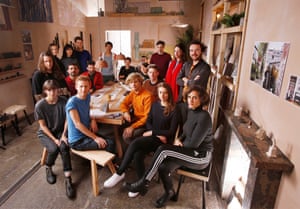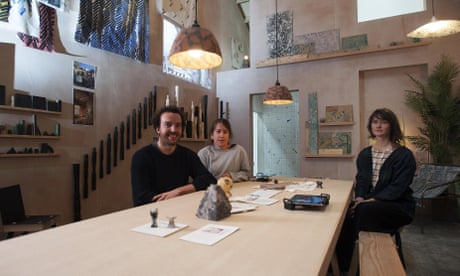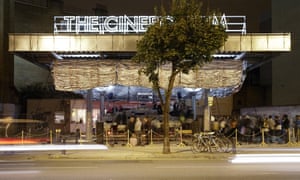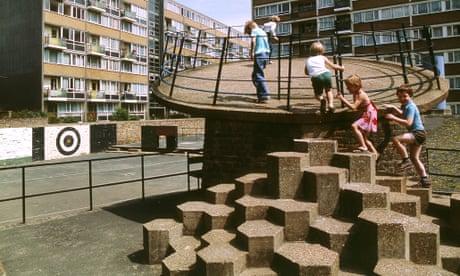Turner prize winners Assemble: 'Art? We're more interested in plumbing'
It’s been declared the death of the Turner prize: a bunch of radical young architects winning instead of an artist. Are Assemble bothered? No – they’re too busy working out how to change the world over a few pints

‘Our work can’t be boiled down into an acceptance speech, or even into a manifesto’ … Turner prize-winning architectural collective Assemble. Photograph: Murdo Macleod for the Guardian

Charlotte Higgins
Tuesday 8 December 2015 18.28 GMTLast modified on Tuesday 8 December 201522.26 GMT
Well, that threw a hand grenade into the Turner prize. In his third week as director of Tate Britain, and therefore as the new chairman of the Turner jury, Alex Farquharson has presided over a group of judges who have handed the prize to a collective of young architects. That’s architects, not artists. To some, it seems like a monumental category error, like giving the Man Booker to, say, an oral poet.

Urban regenerators Assemble become first 'non-artists' to win Turner prize
Read more
At the prize ceremony at Tramway in Glasgow on Monday night, while one corner of the room erupted with justified delight, there was an air of frustration elsewhere. One artist told me that we had been present at the death of the Turner prize. Another was bewildered by the fact that, on the one night of the year that a visual artist might be celebrated and their work brought to a wider audience, the jury had seemed to declare their own artform irrelevant. For once, the annual “but is it art?” Turner prize conversation was being conducted by artists themselves, rather than by sceptical onlookers.
The morning after the night before, four of the 18-or-so Assemble crew pitch up at Tramway to talk about their work – exceptionally chirpy and articulate given the previous night’s partying, including a 2.30am stop-off at McDonald’s to top up the exiguous party canapes. They were, they say, as surprised as anyone to have been nominated. Do they think they are artists? Louis Schulz, 27, studied history and politics, ran a farmer’s market and worked as a court clerk before joining Assemble. “Before this it’s not something we ever bothered to think about,” he says. “And it’s funny, because we are not in control of this perception of us as artists or not. For us it’s not that important: it’s an academic discussion. We are more interested in doing good projects.” Maria Lisogorskaya, 28, adds: “Sometimes that’s about doing really good plumbing.”
For once, the annual 'but is it art?' conversation was being conducted by artists themselves, rather than by sceptics
That’s the key, perhaps: if you believe art is about taking the intellect and imagination into uncharted places, unsettling or ecstatic as that may be, “really good plumbing”, solving a practical problem, doesn’t fit the category. Architecture is, to use Lisogorskaya’s words, about “messy everyday reality”. When they talk about their own work, they use words such as interdisciplinary; they talk about research and listening hard to the needs of communities; they talk about the actual built fabric that might result from a project as not necessarily the most important aspect of their job, which is sometimes as much about setting up an organisation or scheme. (Such as the Baltic Street playground in Glasgow, made for the Commonwealth Games and currently in need of a funding boost to keep it open.)
The label of artist is one they seem perfectly relaxed to have thrust upon them, but not one that they sought; nor do they talk about their work as art. If Turner prizes are in the business of sending out big signals, this year’s seems to be aiming a gun at the domination of the market in art, pointedly rewarding community-based work, and completely redefining the notion of what it is to be an artist.

FacebookTwitterPinterest Cairns Street in the Granby Four Streets area of Toxteth, Liverpool, where Assemble helped the local community renovate homes and gardens. Photograph: Andrew Teebay/Liverpool Echo
Assemble were given the award for their project in Liverpool’s Granby Four Streets. It revolved around the refurbishment of a group of houses in a community in Toxteth that had been ground down, ignored and disenfranchised over the years, with houses demolished or left to rot. The stalwart residents who remained refused to let others dictate how they should live, and began to clean up, planting gardens and painting murals on the wasted buildings around them. Assemble were brought in to help by the community land trust that now runs the neighbourhood. Aside from the refurbishment of 10 houses, Assemble worked with the community to establish – using the prize nomination as a launchpad –Granby Workshop, a social enterprise selling items for the home, some of them made from the rubble of demolished buildings (reconstituted into bookends, or fireplaces).

FacebookTwitterPinterest Replicas of some of the decorative features created from waste materials during the renovations in Granby Four Streets. Photograph: Murdo Macleod for the Guardian
The story of this neighbourhood is by turns saddening, moving and inspiring. Given the political nature of the project – against the backdrop of the increasing privatisation of civic space, and the history of the deprivations of Liverpool 8 – I wondered why they’d not taken the chance to make more of a statement when accepting the prize, live on Channel 4 News. According to Schulz: “We did consider that, but what can you say in only 60 seconds that doesn’t sound gloating, or too pithy to understand?”
“Or patronising,” Mathew Leung, 27, adds. “The problem is that the work can’t be boiled down into an acceptance speech, or even into a manifesto.”
Assemble was set up by a group of friends. Most of them had graduated from Cambridge in 2009 and were working in architectural practices, on the long road to becoming fully qualified architects. They were starting to feel the itch to do something different. Over Christmas 2009, meeting up at parties, they started to think seriously about it. Paloma Strelitz, 28, says: “Over eight months we’d meet once a week and talk about it, and it started to take shape.” That summer they took holiday time from their jobs and worked on their first project: the conversion of a disused petrol station in London into a temporary cinema. (Schulz hooked up with the young architects because he knew how to install sound systems and projectors.) “There was no imperative,” says Leung. “There was no client.”
For a while Assemble was a hobby, says Lisogorskaya – something they discussed in the pub and at each other’s homes. Then, in 2011, came their first actual grownup commission, with a client: to revivify the New Addington Central Parade in Croydon, turning a car park into a public square. Schulz says: “It was really mental – it felt like when we were nominated for the Turner prize. It was an open competition and we were up against proper architects.”

FacebookTwitterPinterest Assemble’s first project, the Cineroleum, a temporary cinema inside a defunct petrol station. Photograph: Assemble
After around a year, they set themselves up as a company. They acquired their own HQ at Sugarhouse Studios in east London – converting the existing industrial shed themselves and sharing it with other makers and designers. Most of the collective work elsewhere part time. They are paid as freelancers, with some money going into a central pot for the company. They have a complex set of rules and organising principles, all set up so they can work the way they want to, but occasionally (I can see by heads falling into hands) a touch frustrating, and constantly in the process of change and experiment. For example, a question about gender balance in the group leads to a lengthy explanation of the “lunch rota”. As their base lacks local cafes, one person cooks lunch for the others based on a points system – the more meals you are present for, the more you have to cook. At the moment, says Leung, the lunch rota – as good an indication as any of who is working at the moment – contains nine men and six women.

Britain's brutalist playgrounds – in pictures
View gallery
Assemble is deeply pragmatic, which allows a very dynamic, articulate and intriguing group of young people to self-organise and work in ways that suit them. They are hoping the Turner prize will give them a fresh platform: there is a lot to be discussed at the next Assemble “summit”. In the end, it seems that what brings them together is not precisely a set of principles, or even a shared approach, but a common conversation. I ask, for example, what if a hypothetical super-rich client asked for a luxury house with all the trimmings and an underground swimming pool? Would they take on such a project?
Schulz explains that when work comes in, an email goes round, and everyone has the chance to express interest. “We can’t say whether we’d do it or not. It doesn’t sound like our kind of thing – but we wouldn’t rule it out.” It depends on the client, puts in Lisogorskaya. “Maybe if they could make the swimming pool open access at the weekend … ?” Leung adds: “You spend a lot of time debating because you have to judge everything on a case-by-case basis. There’s no hard and fast line: our work is a reflection of what people want to do.”
Strelitz chips in: when she thinks about why she carries on with Assemble,, she says, it is because “you can work out how you could do something in the world. Like – how could you build something under a motorway? That feels like a really interesting question to ask over a few pints. Being part of Assemble has always felt like the best conversation you could possibly have.”

沒有留言:
張貼留言